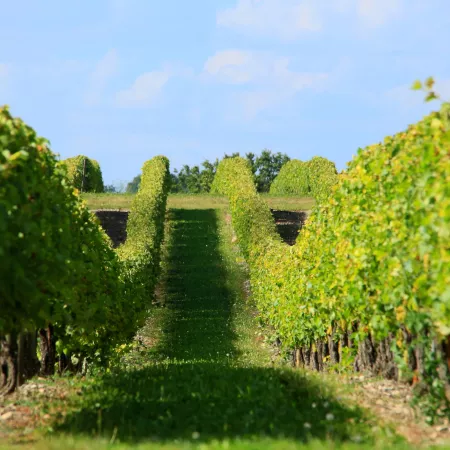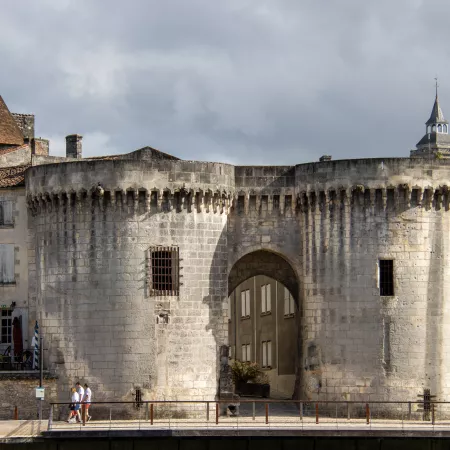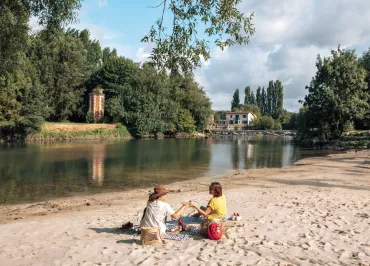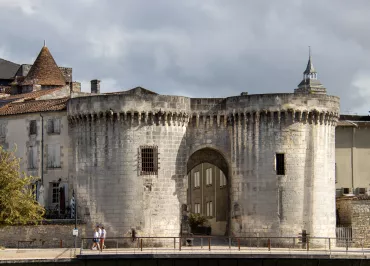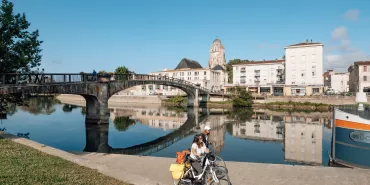Cognac
The main town of the cognac merchants
The names of the great cognac spirit trading firms have spread far and wide, making this Charentais town famous across the world. Distilling is a way of life here. Dismount to explore not just Cognac, but also neighbouring Jarnac, another town where the maisons de négoce open their doors to visitors.
Take a tour of the cognac cellars
Enjoy an urban break beside the Charente River and take a tour of one of the cognac-producing firms. On offer – a tour of the cellars and distillery, generally followed by a tasting.
Hennessy, Martell, Camus and Rémy Martin count among the most famous cognac-making firms here. Visitors who particularly appreciate fine architecture will be drawn to visit the Otard cognac company, its seat in Cognac’s former royal castle, or that of Courvoisier, in the neighbouring town of Jarnac, abutting an imposing 19th-century château. The fine architectural ensemble of the cognac-producing company Meukow also boasts a fine interior of the same period, its cellars for barrel-ageing now set up as a fine space for visitors to tour. These cognac companies, as well as many further more secretive ones, will happily share their passion for the exceptional local liqueur, with its distinctive amber colours, produced from grapes grown in the local vineyards.
You’ll learn everything there is to know about the spirit of cognac by visiting some local cellars. From the process for creating the famed Charentais liqueur to the history of the merchant families who, for generation upon generation, have made the product famed far and wide. All the stages in the creation of cognac will be revealed, from harvesting and distillation to blending and ageing.
Discovering Cognac, designated a Ville d’Art et d’Histoire
Cycling around the town of Cognac, you’ll be struck by the blackened walls of so many of the fine town houses. Their dark patina comes from the action of a microscopic mushroom that thrives on the evaporating cognac (this evaporating percentage of the liqueur known as the part des anges, or angel’s share!). Simply by looking at the façades of the buildings, you can work out in which beautiful town houses cognac has been aged!
Designated a Ville d’Art et d’Histoire for its cultural riches, Cognac is a little town on a human scale that is packed with architectural treasures, bearing witness to the golden age of the trade in the renowned local cognac spirit. The town, also the birthplace of the mighty French king François I, attracts many visitors to its cellars as well as to the architectural heritage to be admired in the historic old town.
Two walking circuits, clearly indicated by fitting signage, enable visitors to discover Cognac town’s major edifices: the Parcours du Roy; and the Circuit Belle Époque.
Make the most of a stop in the town of Cognac to visit the Espace Découverte en Pays du Cognac and the Musée des Arts du Cognac, set side-by-side in a contemporary architectural setting. The Espace Découverte en Pays du Cognac is a visitor centre focusing on the history and heritage of the cognac-producing area. Plus, the Romanesque art and architecture that still mark the countryside where the cognac-producing vines grow are put to the fore. As to the Musée des Arts du Cognac, it tells the story of the vines, men, terroir and local know-how that have produced cognac liqueur, immersing you in a human, industrial and commercial adventure that has made the name of the area, its spirit recognized all over the world.
How Charente’s famous spirit, cognac, is made
Cognac is one of the rare, famous spirits made from grapes. The way it’s produced is complex and lengthy, involving a great deal of know-how in several spheres. At the outset, cognac dervies from a white grape variety, ugni blanc, originally from Italy, but grown in France since the Middle Ages.
In the autumn, the grapes are harvested. They are then pressed to make juice, which is left to ferment. Distillation happens in winter. It involves two distillations (chauffes) making use of an alambic, or distilling still, made of red copper; the shape of the stills in these parts is so original that the local type of still is known as an alambic charentais.
The wine produced from the first distillation is called the brouillis in the region. This is distilled a second time to turn it into an eau-de-vie, or spirit. This spirit is then transferred to oak barrels, to age for many years, kept in dark chais, or cellars.
Finally, the cognac producers make blends of the various spirits in their barrels, in order to make a blended quality product that is guaranteed by a specific regional Appellation d'Origine Contrôlée. The cognac recipe concocted by each producer is preciously kept by the maître de chais, or cellar master, who makes sure their cognac has a unique flavour that makes their brand uniquely recognizable.
